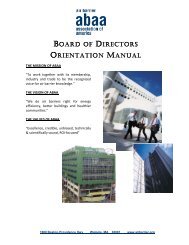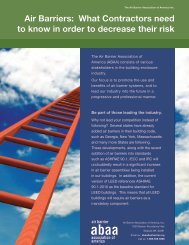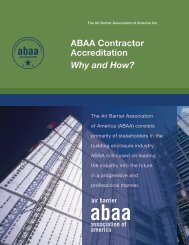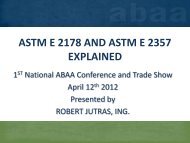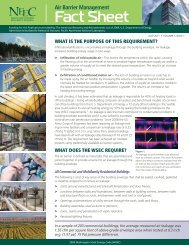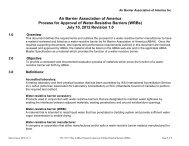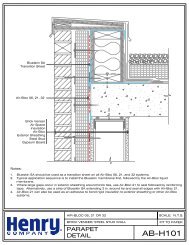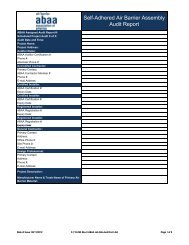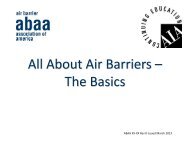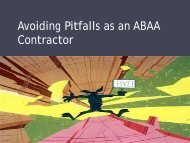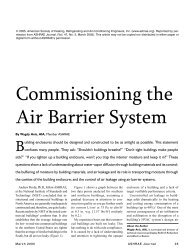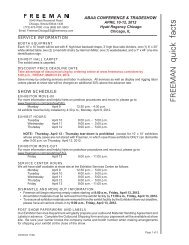Air Barrier Master Specification
Air Barrier Master Specification
Air Barrier Master Specification
Create successful ePaper yourself
Turn your PDF publications into a flip-book with our unique Google optimized e-Paper software.
2400 Spring Stuebner Road, Spring, Texas 77389<br />
5. Exterior face: ½ inch minimum Type X Exterior Gypsum Wall board, affixed to<br />
the metal studs as described in the section 3. Covered with building wrap material.<br />
6. Exterior Claddings:<br />
a. minimum 5/16-inch HardiPanel<br />
b. minimum ¾-inch Stucco or Portland Cement<br />
c. minimum 2-inch natural stone (granite, limestone, marble and sandstone)<br />
d. minimum 1-1/2 inch artificial cast stone<br />
e. minimum 2-inches concrete masonry units<br />
f. minimum 2-inches clay brick veneer.<br />
g. any NFPA 285 approved exterior cladding over the same base wall.<br />
L. Exothermic Caution:<br />
1. Polyurethane foam shall be sprayed in minimum 1/2 inch (12.7 mm) thick<br />
passes or lifts. Overall thickness applied in one pass shall be limited to a maximum 3<br />
inches for EcoBay CC closed cell foam for optimal physical properties.<br />
2. When applying SPF on chlorinated polyvinyl chloride the pass thickness for<br />
EcoBay CC must be limited to 2 inches. If additional thickness is required it must<br />
applied within 15 minutes.<br />
3. If a second pass is needed, wait 10 to 15 minutes between passes to allow<br />
reaction heat to dissipate. If more passes are needed, wait 30 minutes between<br />
passes to allow reaction heat to dissipate.<br />
4. The exothermic reaction can cause temporary substrate thermal rises in<br />
excess of 150 degrees F, which may result in substrate thermal expansion. If the<br />
substrate then contracts when the reaction heat dissipates, substrate deformation<br />
can occur.<br />
5. The full thickness of spray polyurethane foam to be applied within any given<br />
area should be completed in one day.<br />
M. Vapor Retarder Application:<br />
1. When required, a vapor retarder shall be applied to the substrate to be<br />
insulated or to the finished spray polyurethane foam insulation. The predominant<br />
direction of the vapor drive determines the location of the vapor retarder relative to<br />
the spray polyurethane foam. A minimum of one inch of EcoBay CC closed-cell foam<br />
constitutes a vapor retarder where permitted by code.<br />
2. Apply thermal barriers and vapor retarder (if required) according to ICC<br />
recommendations.<br />
3.5 ACCESSORY APPLICATION<br />
A. Joint Filler Foam and Caulk: Use joint filler foam and/or caulk to seal around<br />
windows, doors, chimneys, electrical raceways, sill plates, multiple studs, etc.<br />
Expansion of joint filler foam in a confined space can tighten window frames and<br />
door jambs. Use care in these areas to avoid distortion of these members.<br />
B. Vapor retarders are specified in Section 07260.<br />
C. <strong>Air</strong> barriers are specified in Section 07270.<br />
3.6 FIELD QUALITY CONTROL<br />
A. Protect installed products until completion of project.<br />
07214-9



